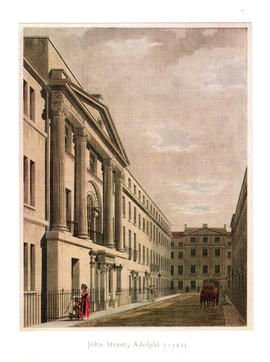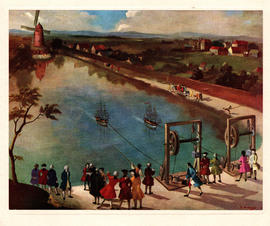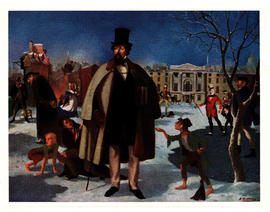In 1758 the Society made the first of its many awards intended to promote reafforestation in Great Britain. A gold medal was awarded to Henry, fifth Duke of Beaufort, to mark the planting of acorns 'for the raising of Oak Timber' upon 23 acres of his estate at Hawkesbury, Gloucestershire. The artist, Anna Zinkeisen has depicted the Duke (in a red coat) listening as his steward, Robert Croucher, reads an advertisement of the conditions upon which the Society's offer of the medal was made. The mounted figure on the left is the Duke's sister, Lady Anne Somerset. Badminton House, the Duke's seat, can be seen in the distance. 24,000 copies sold.
Painted by Anna Zinkeisen, T R Crampton is third from left, wearing an Inverness cape. Awarded the Society's gold medal in 1846 for his invention of the narrow-gauge locomotive engine. Working from engravings and records preserved at the Science Museum and in the archives, the artist has reproduced not only the design but also the original colouring of the engine. 34,000 copies sold.
Founder and first Secretary of the Society. Minature presented to the Society in 1786, the inscription beneath is based on that of an original copper-plate engraving of the minature executed by Hincks himself. 11,800 copies sold.
On 18th December 1850, Charles Dickens, Vice President, in the Chair, Mr W Bridges Adams read his paper on Railway Influence and Extension. The Adelphi had been an area of mystery for Charles Dickens in his unhappy childhood and David Copperfield, in the same predicament, would wander about the district, finding excitement in the strange inhabitants of the riverside. In the foreground of the painting Dickens is surrounded by his characters and in the background he can be seen arriving at the Society. 31,000 copies sold.


